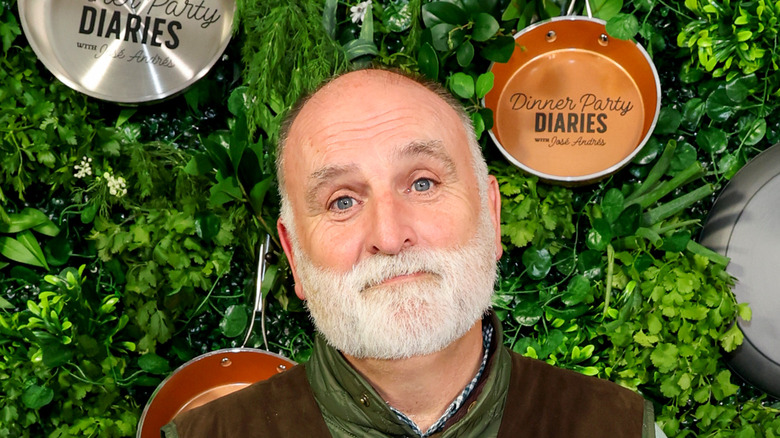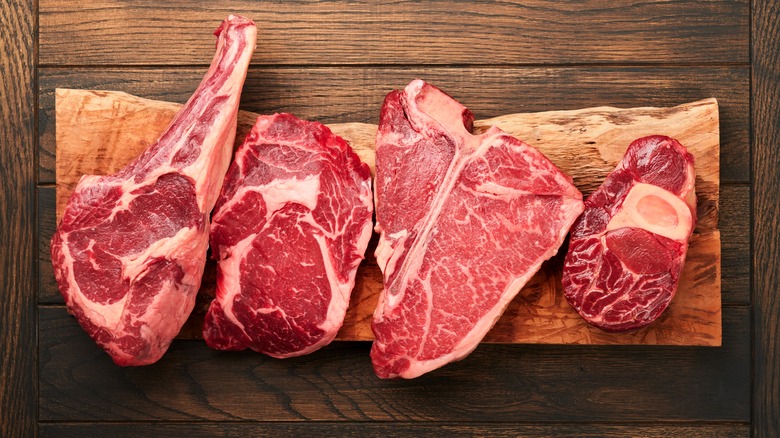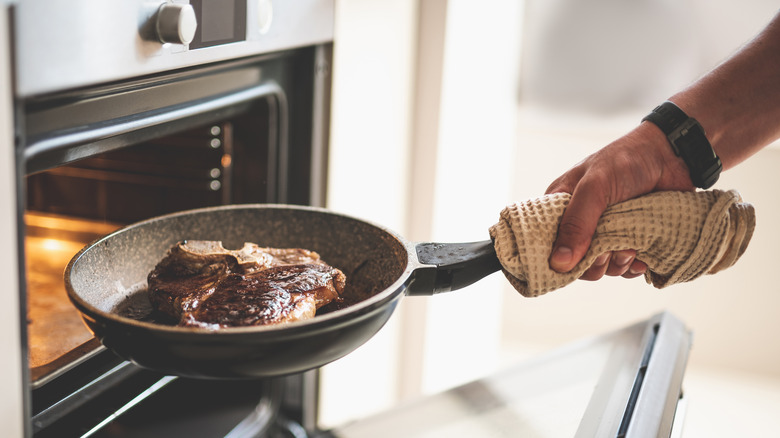José Andrés' Low-And-Slow Process For Meltingly Tender Steak
If you've struggled to get your steak right — you either dry it out too much, or you get a nice external sear (but with an overly bloody interior) — then chef José Andrés has a tip for you. In an interview with Food & Wine, Andrés explained the cooking methods at his restaurant, Bazaar Meat, in Las Vegas' Sahara hotel-casino. While there are reasons why steakhouses use super high heat, instead of slapping the steaks directly onto a high heat grill, the chefs at Bazaar place the meat on a rack about three feet above the heat source in a charcoal oven. The oven slow-roasts cuts of meat to being perfectly cooked (as long as you're okay with rare steak), remaining super juicy inside.
Andrés' method is an extension of one common tip for cooking steak correctly: You should let the meat come to room temperature before it hits the pan or grill by removing it from the refrigerator at least 30 minutes before cooking. This ensures that cold meat doesn't cool the pan down and avoids a cold interior that could end up undercooked. Often, this process alone is referred to as tempering, and Andrés also applies that term to his method. Of course, as a professional, Andrés uses specialty equipment: A Josper charcoal oven imported from Spain, but it's still possible to adapt his method for use at home.
How to temper steak yourself
Obviously, charcoal ovens are not standard in most homes, nor are ovens large enough for you to cook your steak three feet above the heat source. But you can still try it in a regular oven at home — just be sure to have a meat thermometer on hand (which is arguably an essential tool for any kind of steak-cooking, anyway). You'll want an oven around 250 degrees Fahrenheit, and you'll need to place the meat as far away from the heat source as possible. If the oven has both top and bottom elements, try to only use one — perhaps the bottom one, to replicate José Andrés' charcoal-grill approach.
You'll effectively bake the steak until it's done, but be warned that it's a slower process: Andrés recommends some 45 minutes in there, and other sources suggest up to an hour. It can vary depending on how cooked you want it. When it's close to time, break out your thermometer. Andrés says that he cooks it to 110 degrees Fahrenheit, which is a bit below rare. The temperature should increase for other levels of doneness, such as about 130 degrees for medium rare.
The catch with Andrés' method (and a way around it)
As José Andrés himself admits, his tempering method is geared towards people who prefer their steak rare, or maybe a touch more (and obviously, his stellar results are helped by that Spanish charcoal oven). However, the oven can still be used if you prefer your steak more cooked. Another similar cooking method is called reverse searing, which reaps delicious benefits. It also involves cooking the steak in the oven, but it adds a step. The oven will be a similar temperature, but you want to take your steak out when it's maybe 15 degrees below the level of doneness that you want. This may mean slightly less time in the oven than Andrés' method: Perhaps half an hour for rare to medium-rare, but use your meat thermometer to be sure. At that point, take the steak out and put it on a very hot pan or grill, and sear for a maximum of one minute on each side. Because that pan will be much hotter, there's a better chance of water evaporating, making for a slightly less juicy end product. But since it'll be in there very briefly, it should stay relatively moist.
Of course, there's one more shortcoming: The oven method (with or without searing) works best with thick steaks, as thin ones will cook fast and dry out. Plus, it's a slower method than searing or grilling — but the results may well be worth it.


